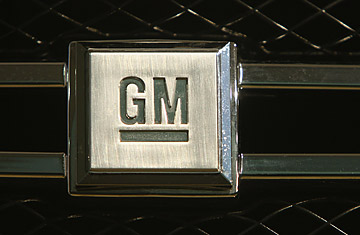
Some analysts have been heartened by GM's November sales results and believe they offer a glimmer of hope for the future — if the government can help the automaker overcome its current cash crunch with a $12 billion loan.
After all, while GM was down 41.3% for the month, Ford Motor, Toyota and Honda — healthier companies all — also reported U.S. sales drops of 30% or more. (Read "Why the Big Three Should Fly Corporate Jets.")
In addition, GM had several strikes against it going into November. Its financial problems were well known, so customers may have been worried about a potential bankruptcy and stayed away. Also, GMAC, GM's finance arm that provides credit to car buyers and dealers is practically out of money itself. It has stopped financing leases and lends money only to the most creditworthy customers. A year ago, GMAC provided financing for nearly half of GM's retail sales. Today that figure is 6%.
But a closer look at the numbers reveals some systemic problems that aren't related to the current credit crunch and that GM will have a hard time overcoming. (Read "GM: Death of an American Dream.")
Unlike its Japanese rivals, GM saw its sales decline begin way back at the beginning of the year, when its truck-heavy product lineup began to sag in the face of higher gasoline prices. So for the first 11 months of 2008, GM's sales have fallen 21.9%. While that is comparable to Ford and Chrysler (down 20.6% and 27.7% respectively), it's far worse than Asian competitors. Toyota is down 13.4% this year, Honda has declined just 5.4%, and Nissan has shrunk by 9.1%. They will be far better positioned to rebound once the market recovers.
Worse from a profitability point of view, GM's product line is currently skewed toward pickups and SUVs, unlike Toyota et al. So declining sales in those segments takes a much bigger bite out of GM's bottom line.
Nor is there much hope to be gleaned from the overall market. Auto sales, and with them an opportunity for a strong GM rebound, aren't expected to recover for quite a while. GM is renowned for its optimistic sales forecasts, but its outlook for the next three years is downright dismal. (Read "The Ripple Effect of a Potential GM Bankruptcy.")
GM's baseline projection for 2009 is industry sales of 12 million cars and trucks — a steep decline from the 16.5 million units sold in 2007, and even from the 13.7 million expected in 2008. Recovery will come slowly. GM projects that industry sales will reach 14.5 million units in 2011 and 15 million units by 2012. As it points out in its restructuring plan, "This is significantly below the 17 million–unit industry levels averaged over the last nine years."
Its downside outlook is even gloomier: 10.5 million units next year, growing to only 12.8 million in 2012. That's right around break-even for a restructured GM.
Even if sales do rebound, GM's opportunities for significant profits will be sharply reduced. It has shuttered several truck and SUV plants and will be switching production to small cars, where GM has traditionally had trouble making money.
Here's one example of the challenges that GM faces. It is investing $750 million in the Chevrolet Volt, a range-extended electric vehicle that is supposed to get 40 miles on a charge of electricity. It is a major technological achievement, but analysts figure that the cost of the extra batteries in the Volt will raise its price to around $40,000. Since sales volume will be very small, GM will lose money on every one. Volt will be great for corporate egos but lousy for the bottom line. (See the Top 10 Bailout Measures.)
In the old days, $750 million was enough to develop a new Cadillac Escalade that would return a variable profit of $10,000 a vehicle. No more. For a restructured GM, the opportunities to produce a return on investment will be a lot more challenging than in the past.
Alex Taylor III is a senior editor at Fortune magazine, where he has covered the auto industry for 23 years.
